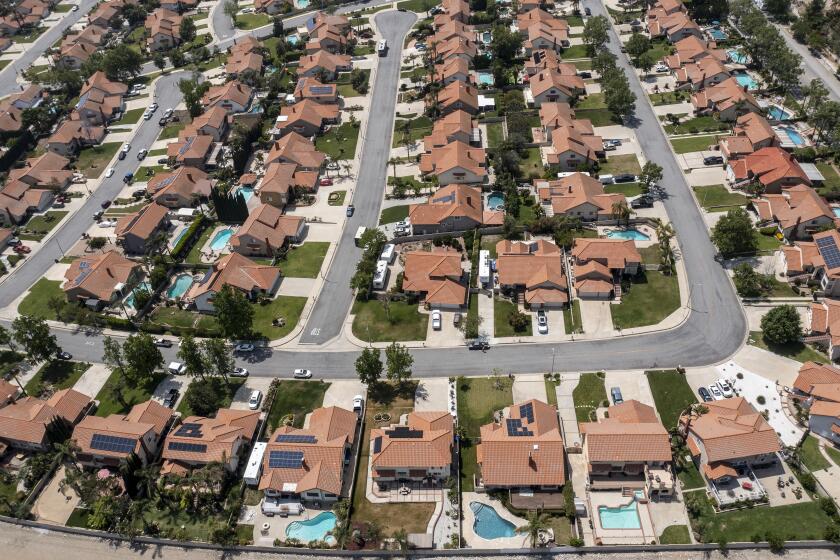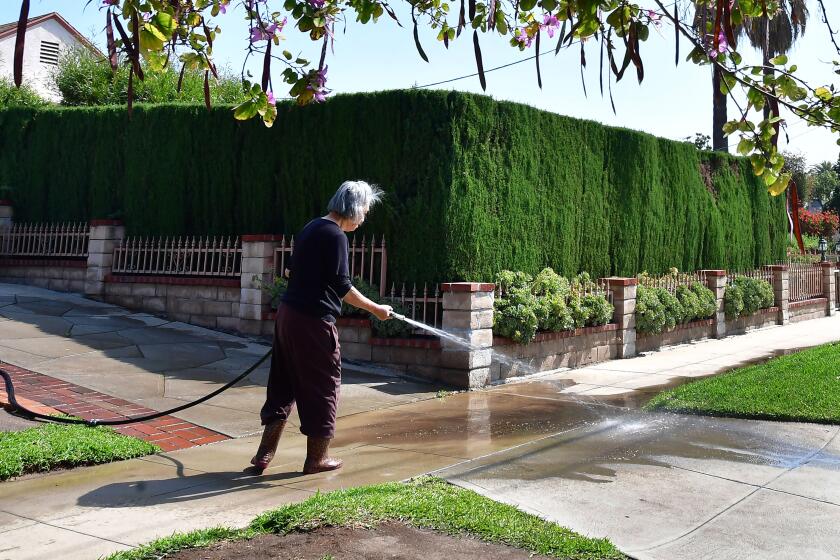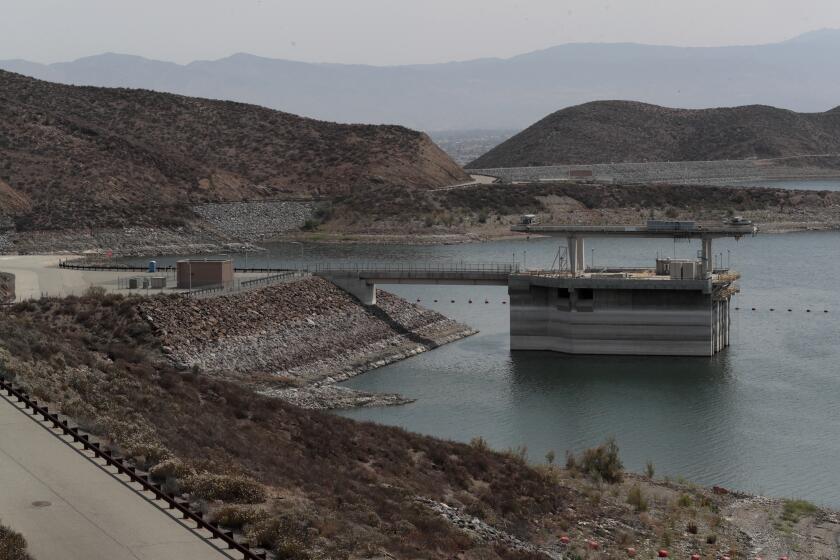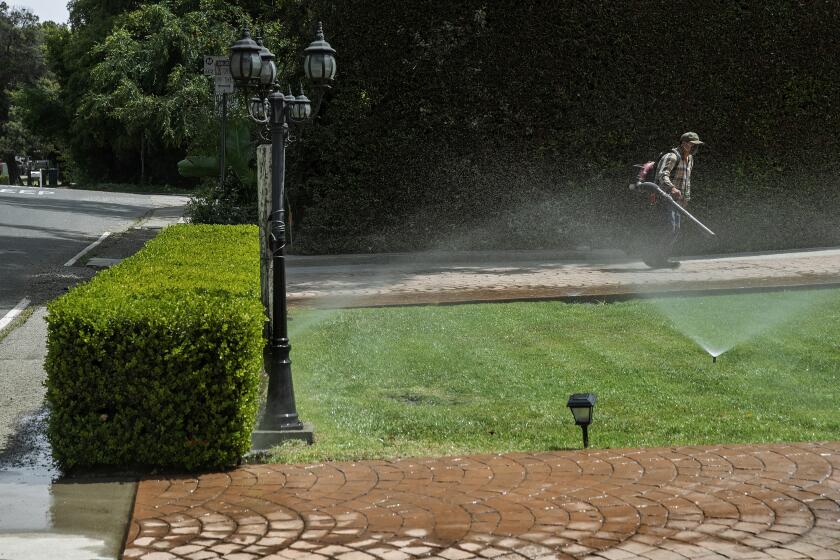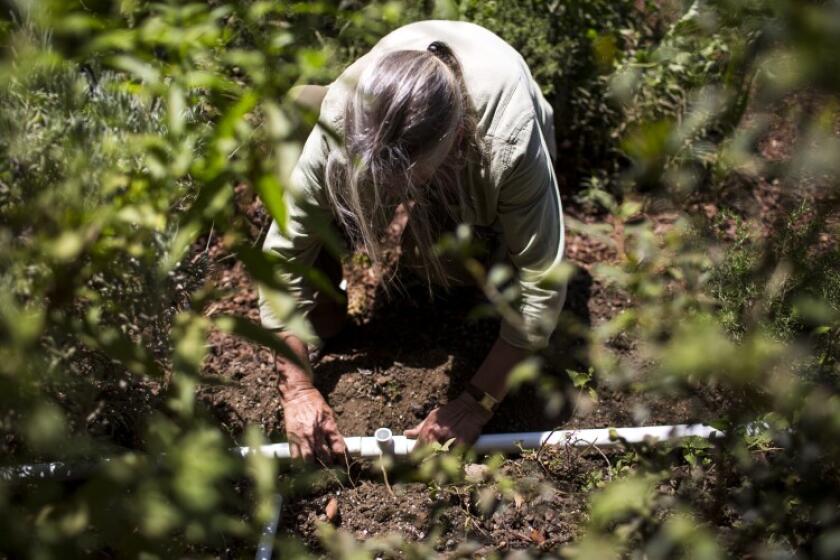Patrols, fines, altered landscapes: How severe SoCal water restrictions will roll out
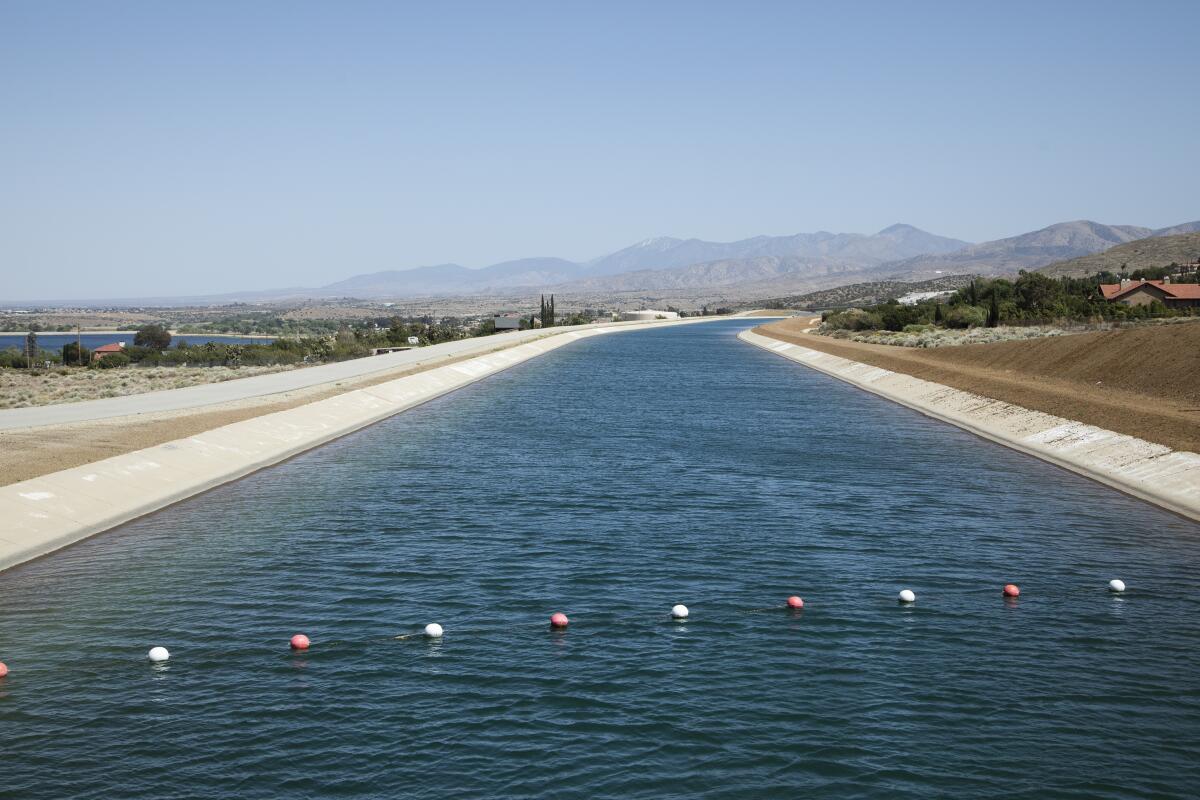
- Share via
More than a week after the Metropolitan Water District of Southern California announced its harshest-ever water restrictions for millions of residents across the region, several of the affected water agencies are offering a preview of how life will change throughout Southland when the rules kick in June 1.
The restrictions target areas that rely heavily or entirely on the State Water Project, a Northern California water supply that officials say is dangerously low after the state’s driest-ever start to the year. The plan was designed to achieve at least a 35% reduction in water consumption, shrinking usage to about 80 gallons per person per day, which can be done through volumetric allocations or one-day-a-week watering limitations.
The MWD’s largest member agency, the Los Angeles Department of Water and Power, has so far offered few details about how the restrictions will be applied to their customers, but said more information will be provided in the coming days.
“Just like other affected agencies, the City of L.A. will determine how it will comply,” DWP officials said in a statement, adding that they are gathering more information before making a recommendation to Mayor Eric Garcetti in compliance with city ordinances. “There is no doubt that a third year of drought and record dry conditions require everyone in Southern California to continue to cut back further on their water use.”
All or part of these cities and communities are dependent on water from the State Water Project and will be affected by new watering restrictions.
But the DWP is only one of six MWD-member agencies affected by the new rules. Some, including the San Bernardino-based Inland Empire Utilities Agency, are themselves wholesalers who are working with their own member agencies to determine the best path forward.
IEUA General Manager Shivaji Deshmukh said the seven major retailers to whom they provide water are each “taking a slightly different approach because each region is different.”
“Some may be heavier when it comes to outdoor use, some may be focused on agriculture, some may be purely residential, so we don’t want to apply the same rule to each different customer when we felt we could achieve real water savings with a tailor-made approach depending on each community,” he said.
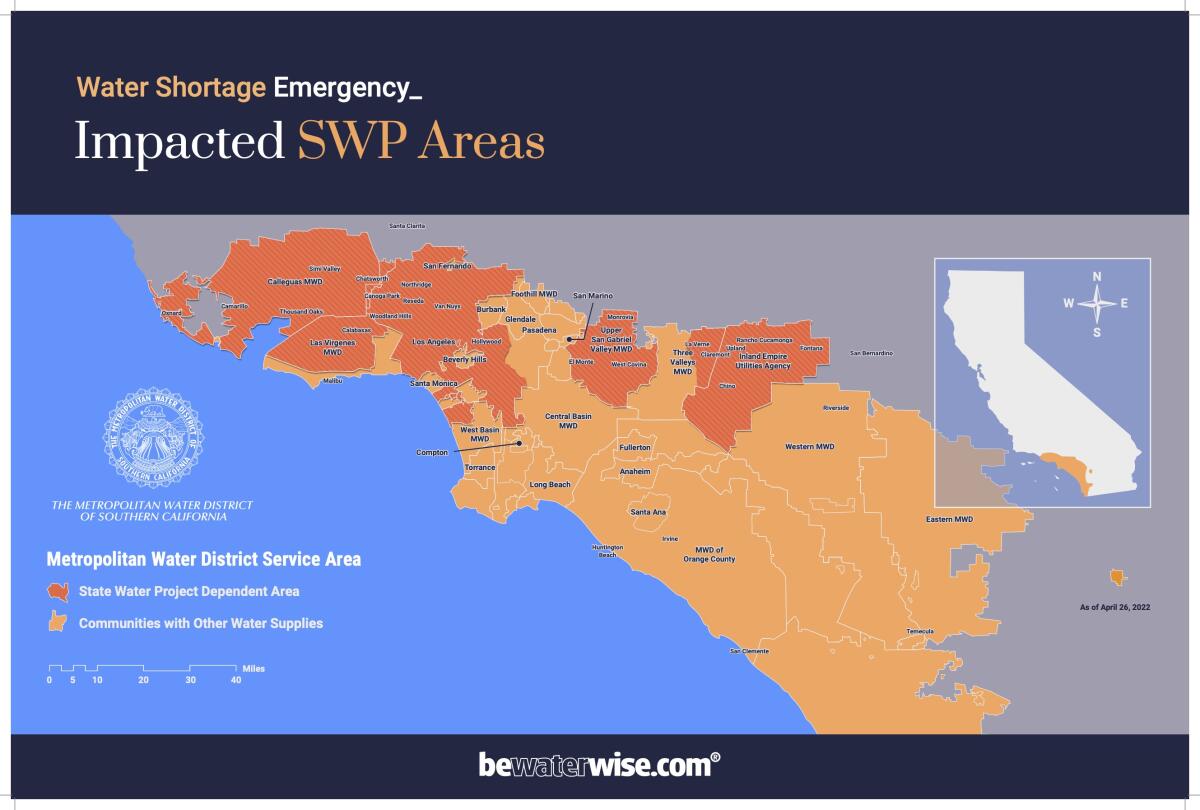
About two-thirds of the IEUA’s water comes from local supplies — including recycled water and groundwater — and about one-third is purchased from the State Water Project via the MWD, Deshmukh said. In all, their service area includes just under 900,000 people in areas such as Chino, Fontana and Ontario.
Given the choice between one-day-a-week watering and volumetric limits, he said, “we felt we wanted to go with the latter, because embedded in that, we can allow each retailer to do what’s best for their service area.”
Deshmukh said the IEUA has also made great strides when it comes to investing in local supplies, including projects to expand wastewater treatment facilities and future plans for additional recycled water, extraction wells and conveyance infrastructure with the help of state loans and funds.
“We built our water transmission systems throughout the West on the hydrology of the past 100 years, and with things changing, we need to be adapting to that,” he said.
Per capita water use in the area — which includes use for agriculture and dairy sectors — is around 170 gallons per person per day, but residential numbers, which are tracked by each retailer, are likely lower, he said. Fines imposed by the MWD for exceeded allocations will in turn be passed down to the appropriate retailers, he added.
Large portions of Southern California are being told to water outdoors just one day a week. And a total watering ban could be imposed by fall.
Meanwhile, the Calleguas Municipal Water District, also a wholesaler, has taken a similar approach, but is more limited in its flexibility because virtually all of its water is from the State Water Project, with only a small fraction from the Colorado River.
“What we’re experiencing right now, this drought, is the worst drought in the history of the State Water Project and in the history of importing water to the Calleguas service area,” said resources manager Dan Drugan.
Calleguas serves 19 water agencies which cover cities in Southeast Ventura County, including Thousand Oaks, Moorpark and Oxnard, and some unincorporated areas.
Like the IEUA, Calleguas plans to “effectively pass through the same plan that Metropolitan put in place for all of its own member agencies” to the retailers they serve, Drugan said. Some are already mobilizing.
“They’ve seen it, they know that it’s coming, and so they’re moving forward with their own adoption ordinances and resolutions to move to that one-day-a-week watering,” he said. “But they will also have the option of that alternative path, where it’s a volumetric reduction based on the available state water that Metropolitan will provide to Calleguas, and we in turn would provide that to the purveyors.”
Drugan said the average annual per capita water use in the Calleguas service area is about 165 gallons per day, but can climb to 175 in the hot, dry summer months.
“This is a big change,” he said. “This is a sudden change. We’re dealing with climate change, and we need folks to change their water use habits with us. That will also involve changing landscaping, and so this is all about change right now. And it’s something that we have to continue to work together on throughout the rest of this year.”
For the first time ever, Southern California water officials will limit outdoor watering to just once a week in certain areas beginning June 1.
Also covered by the MWD’s rules is the Upper San Gabriel Valley Municipal Water District, which provides water to 26 retailers in areas such as Arcadia, Covina, El Monte, Monrovia and South Pasadena.
Agency spokeswoman Patty Cortez said about 80% of their water comes from groundwater, and about 20% is imported from the State Water Project via the MWD.
“For us, it’s looked at as replenishment water,” she said. “But when you have our groundwater basin levels as low as they are because we haven’t had local rain and snow to also help with that replenishment, there is a heavier dependence on state water just to keep our groundwater basin within that safe operating yield.”
Because of that, “to not do anything is not an option for us,” Cortez said. “We’ve asked our retailers to look into going to two days a week with a 20% reduction.”
The reduction, which will go before their board May 11, would mark another tightening for the area, which reduced its daily demand from about 200 gallons per capita prior to the 2014 drought to about 140 gallons during the last five years, according to Cortez.
“I think this is a good success story that our region has been able to keep that lower demand due to the investments our agency and retailers have made in conservation outreach and local water project investments such as recycled water,” she said.
Meanwhile, the nearby Three Valleys Municipal Water District has declared a Level 5 emergency for two cities dependent on State Water Project supplies, Claremont and La Verne, according to chief water resources officer Sylvie Lee.
The declaration calls for 50% conservation with one-day-a-week watering restrictions, and “provides the local retail water agencies the flexibility to implement conservation measures that is best suited for their service area,” Lee said. Claremont’s local service provider is the Golden State Water Co., while the city of La Verne operates its own distribution system.
In all, Three Valleys provides water to 13 agencies in Pomona, Walnut and the East San Gabriel Valley, and is recommending at least a 30% reduction across its entire service area.
Areas that get water from the Colorado River or other sources will be spared from restrictions, at least for now. The strategy has divided experts.
During the previous drought, some Los Angeles neighborhoods were criticized for maintaining their green, grassy lawns — including the celebrity enclave of Calabasas.
Calabasas, along with Agoura Hills, Hidden Hills and Westlake Village, is covered by the Las Virgenes Municipal Water District, which serves about 75,000 residents in those areas. But the agency has already made plans for enforcing the new rules from the MWD, according to spokesman Mike McNutt.
Las Virgenes plans to divvy up watering days among even- and odd-numbered addresses, and then send patrols through the area to ensure that people are complying, McNutt said. They’re also going to keep an eye out for waste, such as water that’s flowing into gutters.
Residents who are not complying will be given door-tag warnings for their first offense, with penalties escalating from there, McNutt said. After three offenses exceeding 150% of the water budget, the agency would be able to install flow-restriction devices.
“It’s not meant to be punitive. It’s meant to get people to understand that this is serious,” he said.
The change will likely be sobering for many people: On average, each residential customer in the area uses approximately 227 gallons of water per day, McNutt said.
The water that cleans your clothes isn’t safe to drink, but it could be good for your plants. Here’s how to use grey water amid drought restrictions.
More to Read
Sign up for Essential California
The most important California stories and recommendations in your inbox every morning.
You may occasionally receive promotional content from the Los Angeles Times.
